
Muscovy Ducks: The Gentle Giants of the Duck World
Last updated on April 7th, 2025 at 07:27 pm
Muscovy ducks are a fascinating and unique addition to any flock, known for their striking appearance, calm demeanor, and impressive size. Unlike most domestic ducks, which are descendants of the mallard (Anas platyrhynchos), Muscovy ducks belong to a different species, Cairina moschata. This distinct lineage brings a variety of unique traits that make Muscovy ducks stand out in the world of duck keeping.
These ducks are not only visually distinctive with their vibrant plumage and pronounced caruncles, but they also offer a range of practical benefits. They are excellent foragers, capable of controlling pests in your garden, and they lay nutritious, edible eggs. Muscovies are known for their quiet nature, communicating through soft hissing and cooing sounds, making them ideal for settings where noise might be a concern.
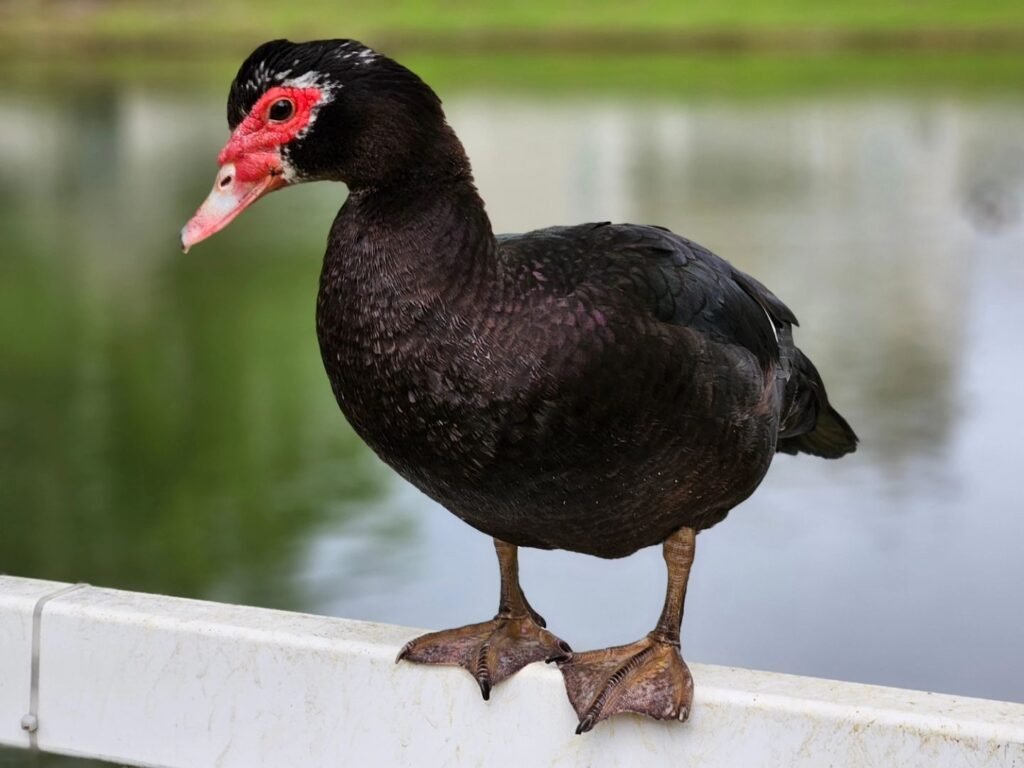
Their adaptability is another key advantage. Muscovy ducks are hardy and can thrive in a variety of climates, from the warm regions of Central and South America to parts of the southern United States where wild populations exist. They are also unique in their ability to fly, often perching in trees or on rooftops, which adds a layer of charm and challenge to their care.
Whether you are an experienced duck keeper or new to the world of ducks, Muscovies bring both beauty and utility to your backyard. Their gentle nature and striking appearance make them a delightful addition to any flock, offering a rewarding experience for those willing to accommodate their unique needs and characteristics.
- Appearance
- Caruncles: The Distinctive Feature of Muscovy Ducks
- Temperament of Muscovy Ducks
- Habitat and Care for Muscovy Ducks
- Heritage and Genetics of Muscovy Ducks
- Hybrid Names and Characteristics
- Differences from Other Domestic Duck Breeds
- Let’s Summarize the Key Points
- Questions for Our Readers:
- Learn About Other Duck Breeds:
- References:
Appearance
They are one of the largest domestic duck breeds, with males weighing up to 15 pounds and females up to 8 pounds. Their plumage comes in a variety of colors, including white, black, blue, chocolate, and lavender, often with striking iridescent patterns. One of the most distinctive features of Muscovy ducks is the caruncles, the red, fleshy growths around their eyes and beak.
Muscovy ducks are easily recognizable by their distinct features:
🦆 Size
- Males: Up to 15 pounds (6.8 kg)
- Females: Up to 8 pounds (3.6 kg)
🦆 Colors
- White: Pure white feathers, often with a glossy sheen
- Black: Deep black plumage with iridescent green or purple highlights
- Blue: Soft gray-blue feathers
- Chocolate: Rich, brown feathers
- Lavender: Light grayish-purple plumage
🦆 Plumage Patterns
- Often have striking iridescent patterns
- Some Muscovies exhibit pied or barred patterns with mixed colors across their bodies
🦆 Caruncles
- Description: Red, fleshy growths around the eyes and beak
- Development: More pronounced in males than females
- Function: Primarily ornamental and a key distinguishing feature of Muscovies
🦆 Bill
- Shape: Broad and flat
- Color: Can vary, typically pink, black, or a combination of both, sometimes with spots or streaks
🦆 Eyes
- Color: Typically brown or black
- Caruncle Surroundings: Often accentuated by the red caruncles

🦆 Feet and Legs
- Color: Usually black or dark gray, but can also be pink or orange depending on the individual
- Webbed Feet: Well-developed for swimming, but Muscovies are also adept walkers and climbers
🦆 Body Shape
- Overall Build: Broad and elongated body compared to other domestic ducks
- Chest: Prominent, giving them a robust and sturdy appearance
🦆 Feather Texture
- Quality: Glossy and smooth
- Wing Feathers: Strong and capable of sustained flight
🦆 Tail
- Length: Relatively long compared to other ducks
- Shape: Fan-shaped when fanned out; typically held flat against the body when relaxed
🦆 Sexual Dimorphism
- Males: Larger, more pronounced caruncles, broader bodies, and more vivid plumage
- Females: Smaller, less pronounced caruncles, and more subdued coloration
🦆 Juvenile Appearance
- Ducklings: Yellow and brown down feathers; less pronounced caruncles which develop as they mature
- Adolescents: Begin to develop adult plumage and caruncles, though colors may still be muted until full maturity
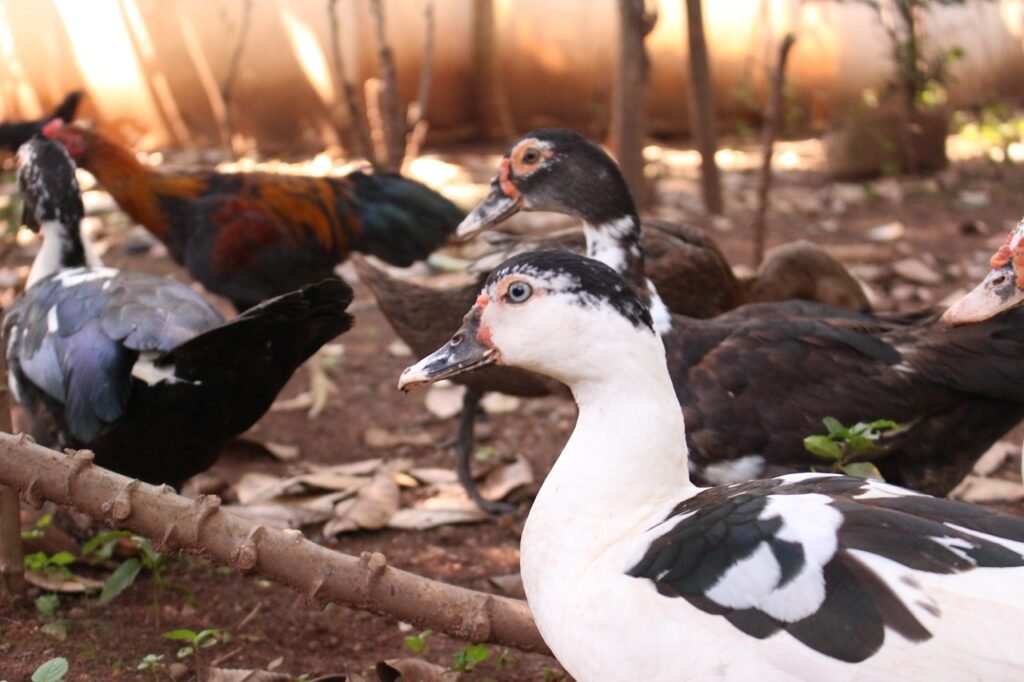
Caruncles: The Distinctive Feature of Muscovy Ducks
Caruncles are one of the most distinctive and striking features of Muscovy ducks, setting them apart from other domestic duck breeds. These fleshy, red growths add to their unique appearance and serve several functions beyond mere ornamentation.
What Are Caruncles?
- Description: Caruncles are red, fleshy protrusions located around the eyes and beak of Muscovy ducks. They vary in size and prominence between individual ducks, with males generally having more pronounced caruncles than females.
- Composition: Caruncles are made of soft, vascular tissue covered with a thin layer of skin. They can have a somewhat warty or bumpy texture, and their color can range from bright red to deeper shades depending on the individual duck’s health and genetics.
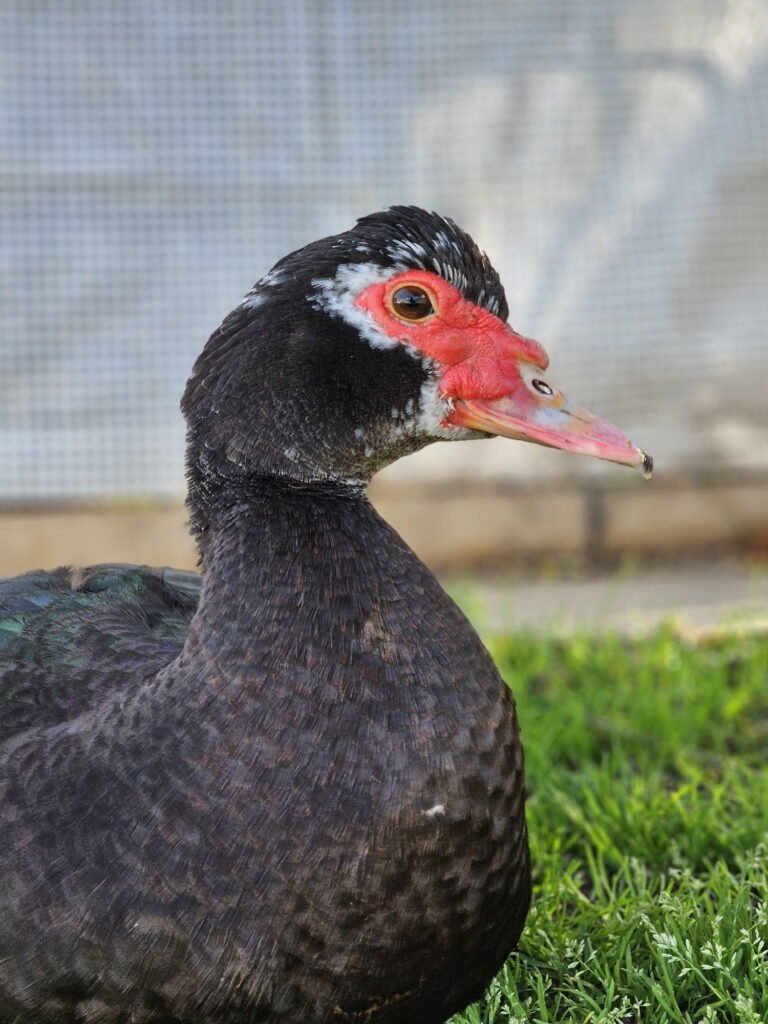
Functions and Benefits of Caruncles
- Sexual Dimorphism:
- Males: The caruncles of male Muscovies are typically larger and more elaborate, which is a key indicator of their gender. This pronounced feature plays a role in sexual selection, helping females identify potential mates with desirable traits.
- Females: While females also have caruncles, they are smaller and less pronounced. This sexual dimorphism highlights the role of caruncles in mate attraction and reproductive behaviors.
- Species Identification:
- Caruncles are a distinctive feature of Muscovy ducks, setting them apart from other domestic duck breeds, which do not have this characteristic. This unique trait helps in identifying Muscovies among other duck species and breeds.
- Temperature Regulation:
- The caruncles may assist in regulating body temperature. The vascular tissue in the caruncles helps dissipate heat, which can be particularly useful for Muscovies in warmer climates. The caruncles can act as a heat sink, helping to cool the blood flowing through the area.
- Communication:
- Although not primarily used for communication, caruncles may play a role in the social interactions of Muscovy ducks. Their size and color can be signals to other ducks, influencing social dynamics within a flock.
- Health Indicators:
- The condition and color of caruncles can provide insights into the health of a Muscovy duck. Changes in color, size, or texture may indicate health issues, such as infections or deficiencies. Healthy caruncles are usually vibrant and well-defined.
- Ornamental Appeal:
- Beyond their functional roles, caruncles contribute to the unique and visually striking appearance of Muscovy ducks. They add to the overall aesthetic appeal of these ducks, making them popular among enthusiasts and collectors.
Maintenance and Care
- Cleaning: Caruncles should be kept clean to prevent infections. Regular observation for signs of dirt or debris is important, and gentle cleaning with a damp cloth can help maintain their health.
- Health Monitoring: Regular checks of the caruncles can help detect any abnormalities early. Any significant changes in size, color, or texture should be assessed by a veterinarian.
Caruncles are a defining feature of Muscovy ducks, serving multiple roles from sexual selection to temperature regulation. Understanding and caring for these unique structures enhances the overall care and appreciation of Muscovy ducks, highlighting their special place in the world of duck keeping.
Temperament of Muscovy Ducks
Muscovy ducks are renowned for their unique and gentle temperament, which makes them a beloved choice among duck enthusiasts. Their behavior and personality traits set them apart from other domestic duck breeds, contributing to their charm and appeal.
Key Aspects of Muscovy Duck Temperament
- Calm and Quiet:
- Muscovy ducks are known for their calm demeanor. Unlike many other domestic ducks that can be quite noisy, Muscovies are relatively quiet. They communicate through soft hisses and coos rather than loud quacking, making them ideal for environments where noise might be a concern.
- Their quiet nature also makes them more suitable for urban or suburban settings where neighbors might be sensitive to loud sounds.
- Gentle and Affectionate:
- Muscovies are generally gentle and friendly birds. They can form close bonds with their human caretakers and often show a degree of affection. They may approach people willingly, and some even enjoy being hand-fed or gently petted.
- This affectionate behavior can make Muscovies enjoyable companions, especially for those who spend time interacting with their ducks daily.
- Curious and Intelligent:
- Muscovy ducks are curious and intelligent, often exploring their environment with great interest. They are keen foragers and enjoy searching for insects, plants, and other food sources. Their inquisitive nature means they need mental stimulation to stay happy and engaged.
- Providing enrichment activities, such as hiding treats or offering new objects to explore, can help keep them entertained and mentally stimulated.
- Independent and Territorial:
- While Muscovies are friendly, they also exhibit a degree of independence and territoriality. They are capable of foraging and finding food on their own, reducing the need for constant supervision.
- They may establish territories within their living area and can sometimes show protective behavior towards their space or nesting sites. Providing them with ample space and resources can help mitigate any territorial disputes.
- Social Dynamics:
- Muscovy ducks generally get along well with other ducks and animals, though their social dynamics can vary. They tend to form strong bonds within their flock and establish hierarchies based on social interactions.
- Introducing new ducks or animals into the flock should be done gradually to prevent conflicts and allow time for adjustment.
- Mothering Instincts:
- Female Muscovies are known for their strong mothering instincts. They are attentive and protective mothers, often taking great care in raising their ducklings. They build nests and incubate their eggs with dedication, ensuring the safety and well-being of their offspring.
- Adaptability:
- Muscovies are adaptable to various living conditions. They can thrive in different climates, from tropical to temperate regions, and adjust well to changes in their environment.
- Their adaptability extends to their social environment as well, as they can integrate into diverse flock compositions and living arrangements.
Care Considerations
- Social Interaction: Regular interaction and engagement with Muscovy ducks can enhance their well-being and strengthen the bond between ducks and caretakers. Positive interactions help maintain their gentle nature and overall happiness.
- Enrichment: Providing environmental enrichment and opportunities for natural behaviors, such as foraging and exploring, is essential for their mental stimulation and contentment.
- Health Monitoring: Keeping an eye on their behavior can also help detect any health issues early. Changes in temperament or social behavior may indicate underlying health problems.
The temperament of Muscovy ducks makes them an appealing choice for many duck enthusiasts. Their calm, affectionate, and curious nature, combined with their ability to adapt and integrate into various environments, contributes to their status as one of the more unique and desirable duck breeds.
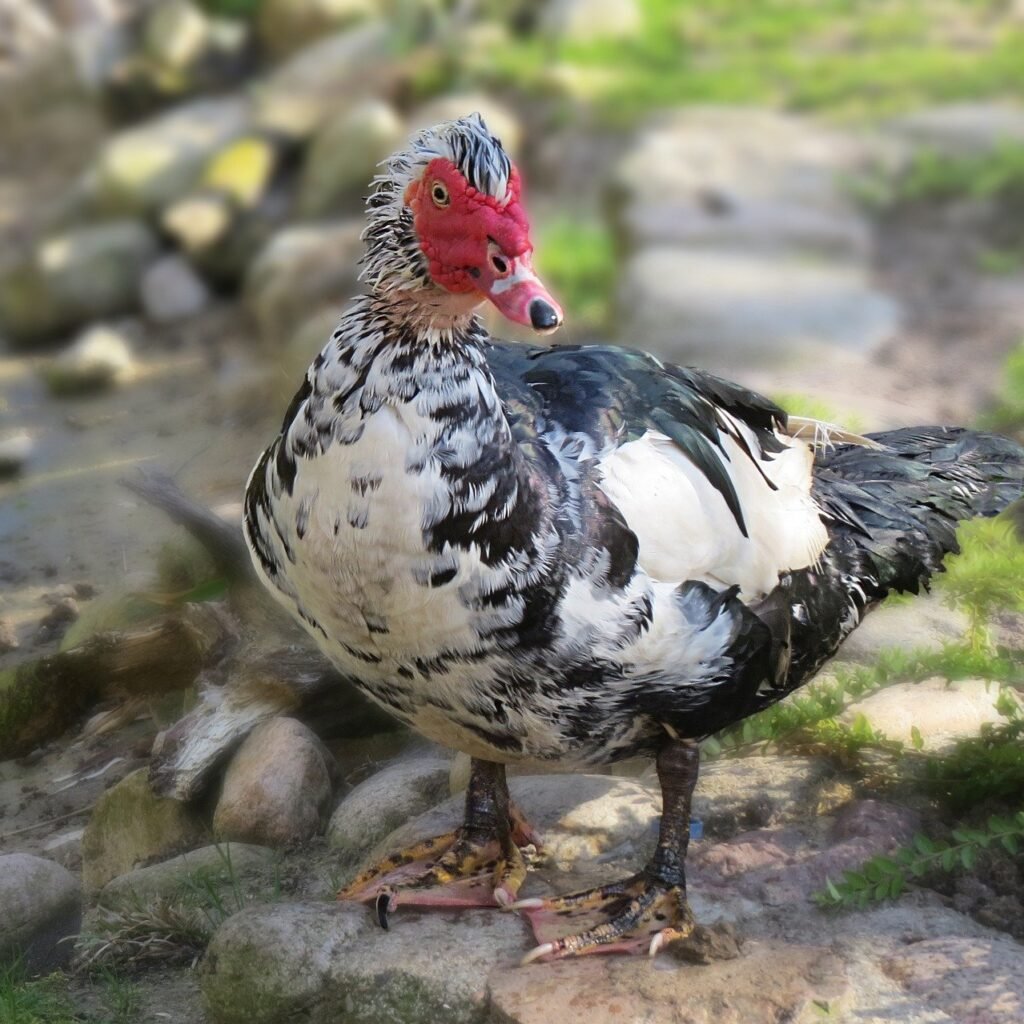
Habitat and Care for Muscovy Ducks
Providing an appropriate habitat and care for Muscovy ducks is crucial to ensuring their health and well-being. These ducks have specific needs and preferences that must be met to keep them happy and thriving. Here’s a comprehensive guide to their habitat requirements and care.
Habitat Requirements
- Shelter
- Size and Structure: Muscovy ducks need a spacious and well-ventilated shelter to protect them from the elements. The shelter should be large enough to allow for comfortable movement and include areas for resting and nesting.
- Insulation: In colder climates, the shelter should be insulated to keep the ducks warm during winter. Adding straw or hay for bedding can help with insulation and provide a comfortable resting area.
- Ventilation: Proper ventilation is essential to prevent humidity buildup and ammonia accumulation, which can lead to respiratory issues. Ensure that the shelter has adequate airflow while protecting the ducks from drafts.
- Outdoor Space
- Free-Range Area: Muscovy ducks thrive in environments where they can roam freely and forage. A secure, fenced area allows them to explore, graze, and engage in natural behaviors.
- Pond or Water Source: While Muscovy ducks are less dependent on water compared to other breeds, having access to a pond or shallow water source is beneficial. They enjoy swimming, and it helps with feather maintenance and hygiene.
- Foraging Grounds: Provide a diverse environment with grass, plants, and insects for them to forage. Muscovies are excellent foragers and benefit from a varied diet that includes natural food sources.
- Nesting Areas
- Nesting Boxes: Female Muscovies need secure and quiet nesting boxes for laying eggs. The boxes should be placed in a sheltered area of the shelter and lined with straw or hay to create a comfortable nesting environment.
- Privacy: Ensure that nesting areas are private and free from disturbances to encourage successful laying and incubation.
- Climate Adaptability
- Temperature: Muscovy ducks are adaptable to various climates. In hot weather, provide shaded areas and access to cool water to prevent overheating. In cold weather, ensure that the shelter is adequately insulated and protected from wind and rain.
- Humidity: Maintain appropriate humidity levels in the shelter to prevent respiratory issues and keep the ducks comfortable.
Perching and Flight
- Perches: Muscovy ducks enjoy perching and often seek elevated spots to rest and observe their surroundings. Provide perches or raised platforms within their shelter to accommodate this natural behavior. Ensure that perches are sturdy and positioned at varying heights to cater to all ducks.
- Flight: Unlike many domestic ducks, Muscovy ducks are capable of flying. They use their flight ability to escape predators, explore their environment, and reach elevated resting spots. If you want to restrict their flight, consider clipping their wings or providing a secure aviary.
- Wing Clipping: Clipping one wing can help reduce their ability to fly, which might be necessary in some environments to prevent them from escaping or getting into dangerous situations. Consult a veterinarian or experienced duck keeper for proper wing clipping techniques.
- Aviary: Alternatively, an enclosed aviary can provide a safe space for Muscovy ducks to fly and exercise while preventing them from leaving the area. An aviary should be large enough to allow them to spread their wings and fly short distances.
Care and Management
- Feeding
- Balanced Diet: Muscovy ducks require a balanced diet to stay healthy. Provide a high-quality duck feed formulated for their age and stage of life. Supplement their diet with fresh vegetables, fruits, and grains for added nutrition.
- Foraging: Allow Muscovy ducks to forage for insects, plants, and other natural food sources. This not only provides them with a varied diet but also helps to keep them engaged and active.
- Water Management
- Clean Water: Provide clean, fresh water for drinking at all times. Muscovy ducks should have access to water that is regularly changed and kept free from contaminants.
- Cleaning: Regularly clean and sanitize water containers to prevent the spread of disease and ensure that the ducks have access to healthy water.
- Health Monitoring
- Regular Check-Ups: Perform regular health check-ups to monitor the ducks for signs of illness or injury. Look for changes in behavior, appetite, or physical appearance that could indicate health issues.
- Vaccinations and Parasite Control: Consult with a veterinarian to determine appropriate vaccinations and parasite control measures. Regular deworming and preventative treatments can help maintain their health.
- Social and Behavioral Needs
- Companionship: Muscovy ducks are social animals and should be kept in pairs or small groups. Providing companionship helps reduce stress and promotes a harmonious social structure.
- Enrichment: Offer enrichment activities, such as toys, objects to peck at, or new environmental features, to keep the ducks mentally stimulated and prevent boredom.
- Handling and Interaction
- Gentle Handling: Handle Muscovy ducks gently and calmly to build trust and reduce stress. Regular, positive interactions help maintain their friendly and affectionate nature.
- Observation: Spend time observing the ducks to understand their behaviors and needs. This helps in addressing any issues promptly and ensuring their overall well-being.
Seasonal Considerations
- Summer Care
- Cooling: Provide shaded areas and cool water for swimming. Ensure that the ducks have access to plenty of fresh water and avoid overexposure to the sun.
- Pest Control: Keep an eye out for pests such as mosquitoes and flies, which can be more prevalent in warmer weather. Regularly clean the habitat to reduce pest attraction.
- Winter Care
- Warmth: Insulate the shelter and provide extra bedding to keep the ducks warm. Ensure that the shelter is dry and free from drafts.
- Water Management: In freezing temperatures, provide a heated water source to prevent water from freezing and ensure that the ducks have access to fresh water.
By addressing these habitat and care requirements, you can create a comfortable and healthy environment for Muscovy ducks, allowing them to thrive and enjoy their unique, gentle nature.
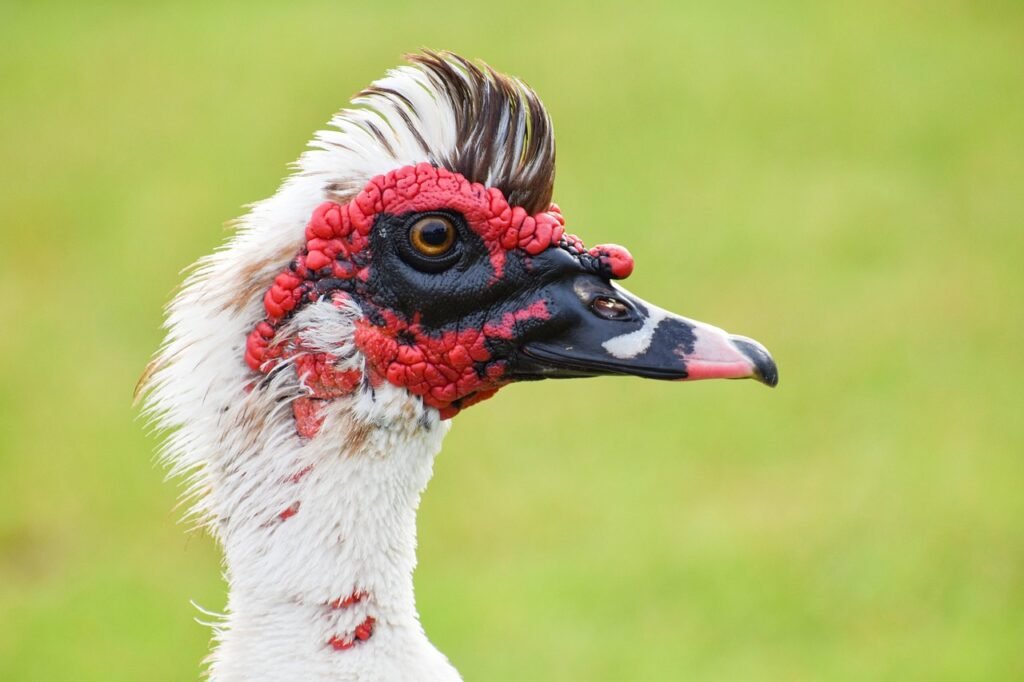
Breeding and Eggs: A Guide to Muscovy Ducks
Breeding Muscovy ducks can be a rewarding experience, especially when you understand their unique reproductive behaviors and requirements. Muscovy ducks have distinct breeding traits and egg-laying patterns that set them apart from other domestic duck breeds. Here’s a comprehensive guide to breeding and egg care for Muscovy ducks.
Broodiness: They are known for their strong brooding instincts and often make excellent mothers, hatching and raising their ducklings with care.
Breeding Muscovy Ducks
- Breeding Season
- Timing: Muscovy ducks typically breed from early spring through summer. Their reproductive cycle is influenced by environmental factors such as temperature and daylight length.
- Mating Behavior: During the breeding season, males become more vocal and display courtship behaviors to attract females. These behaviors include head bobbing, wing flapping, and vocalizations. The female may respond by preening and showing interest in the male.
- Pair Bonding
- Monogamous Relationships: Muscovy ducks are known for forming strong pair bonds. A mated pair will often stay together for the breeding season, and sometimes for life. The bond between the male and female is crucial for successful egg fertilization and rearing of ducklings.
- Nesting Site Selection: The female Muscovy selects a nesting site and prepares it by lining it with feathers, straw, or other materials. Providing secure and private nesting boxes is essential for encouraging successful nesting.
- Nesting and Incubation
- Nesting Boxes: Female Muscovies need quiet, private nesting boxes to lay their eggs. The boxes should be placed in a sheltered area of the duck shelter and lined with straw or hay for comfort.
- Egg Laying: A female Muscovy will lay between 8 to 20 eggs per clutch, with the average being around 12 to 15 eggs. The eggs are usually laid one per day until the clutch is complete.
- Incubation: Once the clutch is complete, the female Muscovy will start incubating the eggs. She will sit on the eggs for about 35 days, keeping them warm with her body heat. During incubation, the female rarely leaves the nest, relying on the male to bring her food and protect the nest.
- Duckling Care
- Hatching: After about 35 days of incubation, the eggs will begin to hatch. The mother will guide the newly hatched ducklings to water and show them how to find food.
- Mothering Instincts: Female Muscovies are attentive mothers. They keep their ducklings warm, protect them from predators, and teach them essential survival skills. Ducklings are typically independent within a few weeks but benefit from their mother’s guidance.
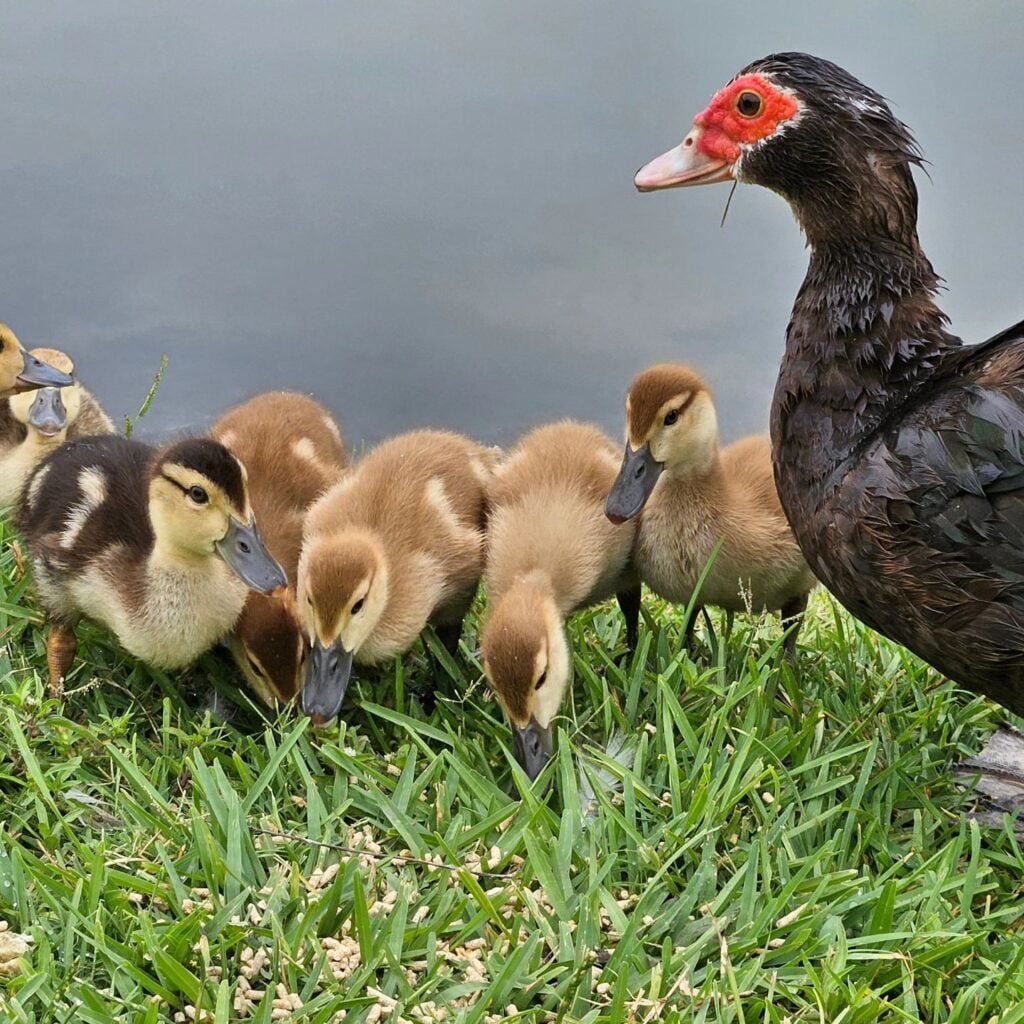
Egg Characteristics
- Appearance
- Color and Size: Muscovy duck eggs are usually white or pale cream in color, although some may have slight speckles. The eggs are larger than those of many other domestic duck breeds, averaging about 2.5 to 3 inches in length.
- Shell Quality: The eggs have a thick, hard shell that provides good protection for the developing embryos. This shell quality helps reduce the risk of breakage during incubation.
- Laying Frequency
- Regular Laying: A female Muscovy duck typically lays eggs once a day during the breeding season. She may lay up to 20 eggs in a single clutch, though clutches of 12 to 15 eggs are more common.
- Seasonal Variation: Egg production can vary based on environmental conditions and the duck’s health. Muscovy ducks may reduce egg production or stop laying during colder months or when experiencing stress.
- Egg Fertility
- Fertility Rate: Eggs laid by a mated pair of Muscovy ducks are generally fertile, provided that the male is actively mating with the female. Fertility rates can be high, but they can also be influenced by factors such as the age and health of the ducks.
- Incubation: Fertile eggs can be successfully incubated by the female or artificially. Artificial incubation requires maintaining proper temperature and humidity levels and turning the eggs regularly to ensure even development.
- Egg Collection and Storage
- Collection: If you do not allow the female to incubate naturally, collect eggs daily to prevent them from becoming soiled or damaged. Store eggs in a cool, dry place until they are ready to be incubated or used.
- Storage Conditions: For best results, store eggs at a consistent temperature of around 55°F (13°C) and keep them in an environment with moderate humidity. Eggs should be turned regularly to prevent the yolk from sticking to the shell.
Special Considerations
- Health and Nutrition: Ensure that breeding Muscovy ducks receive a balanced diet and adequate nutrition to support egg production and overall health. Supplement their feed with vitamins and minerals as needed.
- Environment: Maintain a clean and secure environment to reduce stress and minimize the risk of diseases that could affect breeding success.
By understanding and addressing these aspects of breeding and egg care, you can support the successful reproduction and health of your Muscovy ducks, ensuring that both the adults and their ducklings thrive.
Egg Production: Females lay between 60 to 120 eggs per year, with eggs being slightly larger than those of other duck breeds.
Heritage and Genetics of Muscovy Ducks
Muscovy ducks, scientifically known as Cairina moschata, have a rich heritage and unique genetic makeup that set them apart from other domestic duck breeds. Originating from Central and South America, Muscovies were domesticated by indigenous people long before European settlers arrived in the Americas. Their domestication history spans centuries, during which they have adapted to various environments and purposes.
Origins and Domestication
- Native Range: Muscovy ducks are native to the tropical regions of Central and South America, including Brazil, Mexico, and Colombia. They thrive in warm, humid climates and are often found near rivers, lakes, and wetlands.
- Early Domestication: Indigenous peoples of the Americas domesticated Muscovy ducks for their meat, eggs, and pest control capabilities. They valued Muscovies for their quiet nature and ability to forage for food, reducing the need for extensive feeding.
Genetic Distinction
- Different Species: Unlike most domestic ducks that are descendants of the mallard (Anas platyrhynchos), Muscovy ducks are a separate species (Cairina moschata). This distinction is crucial for understanding their unique traits and behaviors.
- Physical Differences: Muscovies exhibit several physical traits not seen in mallard-derived breeds, such as their large size, caruncles (red, fleshy growths around the eyes and beak), and broader body structure. These features highlight their genetic divergence from other domestic ducks.
- Behavioral Traits: Their quiet communication through hissing and cooing, strong flying ability, and excellent foraging skills also reflect their unique genetic heritage.
Crossbreeding and Hybrids
- Hybridization with Mallards: Muscovy ducks can crossbreed with mallards, resulting in hybrids known as “mule ducks” or “moulards.” These hybrids combine traits from both parent species but are typically sterile, meaning they cannot reproduce. Moulards are often used in the production of foie gras due to their large size and desirable meat qualities.
- Genetic Variability: Crossbreeding highlights the genetic variability within the duck family, showing how distinct species can produce offspring with mixed characteristics. However, the sterility of these hybrids reinforces the genetic boundary between Muscovies and mallard-derived breeds.
Conservation and Genetic Diversity
- Wild Populations: In addition to domesticated Muscovies, wild populations still exist in their native range and in parts of the southern United States, such as Texas and Florida. These wild populations help maintain genetic diversity within the species.
- Breeding Programs: Efforts to conserve and breed Muscovy ducks focus on preserving their unique genetic traits. Responsible breeding practices ensure the continuation of their distinctive characteristics and help avoid issues related to inbreeding.
Muscovy ducks’ heritage and genetics make them a remarkable addition to any flock. Understanding their origins, genetic distinction, and the potential for hybridization provides valuable insights into their care and the benefits they bring to duck enthusiasts. Whether you are captivated by their history, intrigued by their genetics, or simply appreciate their quiet charm, Muscovy ducks offer a fascinating glimpse into the diversity of the duck world.
Hybrid Names and Characteristics
- Muscovy Mom (Dam) x Mallard Dad (Sire)
- Hybrid Name: Hinny
- Characteristics:
- Hinnies tend to resemble their Muscovy mothers more closely in terms of size and body shape.
- They typically have the calm demeanor and foraging skills of Muscovies.
- Their plumage might display a mix of colors from both species but usually leans towards the Muscovy’s more subdued and solid color patterns.
- Uses:
- Hinnies are generally raised for their meat, which combines the qualities of both parent species, often resulting in a leaner and more flavorful product compared to purebred Muscovies or mallards.
- They are also appreciated for their excellent pest control abilities, inheriting strong foraging instincts from their Muscovy mothers.
- Mallard Mom (Dam) x Muscovy Dad (Sire)
- Hybrid Name: Mule Duck
- Characteristics:
- Mule ducks often exhibit a mix of traits from both parents but are usually more similar in size and body shape to mallards.
- They tend to be more vocal than hinnies, reflecting their mallard heritage.
- Their plumage can be more varied and colorful, showcasing a blend of the vibrant patterns typical of mallards and the solid colors of Muscovies.
- Uses:
- Mule ducks are highly prized in the commercial meat industry, particularly for the production of foie gras. Their large size and fast growth rate make them ideal for this purpose.
- They are also valued for their robust health and adaptability, making them suitable for various farming conditions.

Sterility and Genetic Implications
- Sterility: One of the most important aspects of these hybrids is their sterility. Both hinnies and mule ducks are generally sterile, meaning they cannot reproduce. This sterility is due to the significant genetic differences between the two parent species, reinforcing the genetic boundary between Muscovies and mallards.
- Genetic Variability: The sterility of these hybrids prevents them from contributing to the gene pool of either parent species. However, their creation highlights the genetic variability and potential for diverse traits within the duck family.
Special Uses and Considerations
- Meat Production: Both hinnies and mule ducks are primarily raised for their meat, which is a key reason for their popularity in the commercial farming sector. Their meat is known for its rich flavor and lean quality, making it a delicacy in many culinary traditions.
- Pest Control: Due to their strong foraging abilities, especially in hinnies, these hybrids can be beneficial in agricultural settings for natural pest control. They help manage insect populations and reduce the need for chemical pesticides.
- Adaptability: Hybrids often inherit a blend of traits that make them adaptable to various environmental conditions. This adaptability can make them easier to raise and manage compared to purebred ducks.
Understanding the differences between Muscovy mom and dad hybrids, their characteristics, and uses, provides valuable insights for duck enthusiasts and farmers. Whether raised for meat, pest control, or their unique traits, these hybrids offer a fascinating glimpse into the possibilities of duck breeding.
Differences from Other Domestic Duck Breeds
Muscovy ducks stand out from other domestic duck breeds in several significant ways. Unlike most domestic ducks, which are descendants of the mallard (Anas platyrhynchos), Muscovy ducks (Cairina moschata) are a different species altogether. This distinction brings a unique set of characteristics and requirements:
- Species Difference: Muscovy ducks belong to a different species than other domestic ducks. While mallard-derived breeds share a common ancestry, Muscovies come from a separate lineage, giving them distinct physical and behavioral traits.
- Flying Ability: Unlike most domestic ducks, which are typically flightless due to their heavy bodies, Muscovy ducks are excellent fliers. They can fly long distances and often perch in trees or on rooftops. This means that Muscovy owners may need to clip their wings or provide enclosed spaces to keep them from flying away.
- Native Range: Muscovy ducks are native to Central and South America. In the United States, wild populations can be found in Texas and Florida, where they have adapted well to the local environment. This native range contrasts with mallard-derived breeds, which were domesticated in various parts of the world.
- Crossbreeding with Mallards: Muscovy ducks can crossbreed with mallards, resulting in hybrids known as “mule ducks” or “moulards.” These hybrids are generally sterile, meaning they cannot reproduce. This crossbreeding capability is unique to Muscovies and adds an interesting aspect to their genetics.
- Eggs and Laying Frequency: Muscovy duck eggs are slightly larger than those of other domestic ducks and are perfectly edible. Muscovy females typically lay between 60 and 120 eggs per year, depending on their care and environment. This laying frequency is comparable to other domestic breeds, but the larger egg size is a notable difference.
- Appearance and Size: Muscovy ducks come in a variety of colors, including white, black, blue, chocolate, and lavender. Their most distinctive feature is the red caruncles, the fleshy growths around their eyes and beak. In terms of size, males can weigh up to 15 pounds, making them one of the largest domestic duck breeds, while females are smaller, weighing up to 8 pounds. This size difference is more pronounced than in many mallard-derived breeds.
- Temperament: Muscovy ducks are known for their gentle and calm nature. They are quieter than other duck breeds, communicating through soft hissing and cooing sounds rather than loud quacks. Their docile temperament makes them great companions for both humans and other ducks.
- Foraging Ability: Muscovy ducks are excellent foragers and are adept at controlling pests such as insects and small rodents. This foraging ability sets them apart from other domestic breeds, which may not be as efficient in pest control.
- Special Care Considerations: Due to their flying ability, Muscovy ducks require special care to manage their flight. Wing clipping or enclosed spaces may be necessary to keep them safe and contained. Additionally, their perching behavior means they benefit from having sturdy perches in their living area. Muscovies are hardy ducks but need protection from extreme cold, so providing adequate shelter during harsh weather is important.
Understanding these differences helps in providing the best care for Muscovy ducks and appreciating their unique qualities. Whether you are a seasoned duck keeper or new to the duck world, Muscovies offer a distinctive and rewarding experience.
Special Care Considerations
Muscovy ducks require some specific care:
- Perching Needs: Provide perches as they enjoy roosting off the ground.
- Flight Management: Due to their flying ability, you may need to clip their wings or provide an enclosed area to prevent them from wandering too far.
- Climate Adaptability: Although hardy, they need protection from extreme cold and should have access to shelter during harsh weather.

Let’s Summarize the Key Points
Muscovy ducks are a distinctive and fascinating species within the Anatidae family, characterized by their unique traits and behaviors that set them apart from other domestic ducks and geese. Their classification, appearance, and habits reflect a rich evolutionary history and adaptation to diverse environments.
🦆 Unique Traits and Characteristics
Muscovy ducks stand out due to several unique features:
- Facial Caruncles: The prominent, fleshy caruncles on their faces give them a distinctive appearance and are a key identifier. These caruncles are not just for show; they play a role in communication and social interactions among Muscovy ducks.
- Flying Ability: Unlike many domestic ducks, Muscovies are capable fliers. Their ability to fly, combined with their preference for perching, necessitates thoughtful management to ensure their safety and prevent escape. This trait also reflects their natural adaptability and agility.
🥚 Breeding and Egg-laying
The breeding behavior of Muscovy ducks is marked by:
- Strong Pair Bonds: Muscovies often form lifelong pair bonds, demonstrating a level of monogamy that is notable among ducks. This bond is crucial for successful breeding and the care of their young.
- Egg Production: Female Muscovies lay large clutches of eggs, typically ranging from 8 to 20, with a high level of fertility if the pair is healthy and well-cared for. Their nesting behavior includes selecting secluded and secure sites to ensure the safety of their eggs.
🛖 Habitat and Care
Creating an ideal habitat for Muscovy ducks involves:
- Adequate Shelter: Providing a well-ventilated, insulated shelter that protects them from extreme weather conditions is essential for their well-being.
- Outdoor Space: Muscovies thrive in environments where they can forage and explore. Access to a pond or water source enhances their physical health and helps maintain their feathers.
- Perching and Flight: Their natural inclination to perch and fly requires either careful management of their flying ability through wing clipping or the installation of a secure aviary to keep them safe.
In summary, Muscovy ducks are a remarkable species with distinctive physical features, unique behaviors, and specific care requirements. Their ability to fly, strong family bonds, and varied diet highlight their adaptability and complexity. Understanding these aspects of Muscovy ducks enhances the enjoyment and success of keeping them, whether you’re breeding them, caring for them, or simply admiring their unique qualities.

Questions for Our Readers:
- Do you have Muscovy ducks in your flock? Share your experiences with us!
- What do you find most fascinating about Muscovy ducks? Let us know in the comments!
Feel free to join our community and share your quacky adventures with these amazing ducks!
Learn About Other Duck Breeds:
- Cayuga Ducks: The Beautiful Black Duck Breed
- Ancona Duck – A Rare Duck Breed
- Crested Ducks: Pets with a Genetic Defect
- Khaki Campbell: The Champion Egg Layer That Can (Almost) Fly
- Welsh Harlequin Duck – Friendly, Hardy, and Stunningly Unique
- Indian Runner Ducks: The Upright, Active, and Entertaining Breed


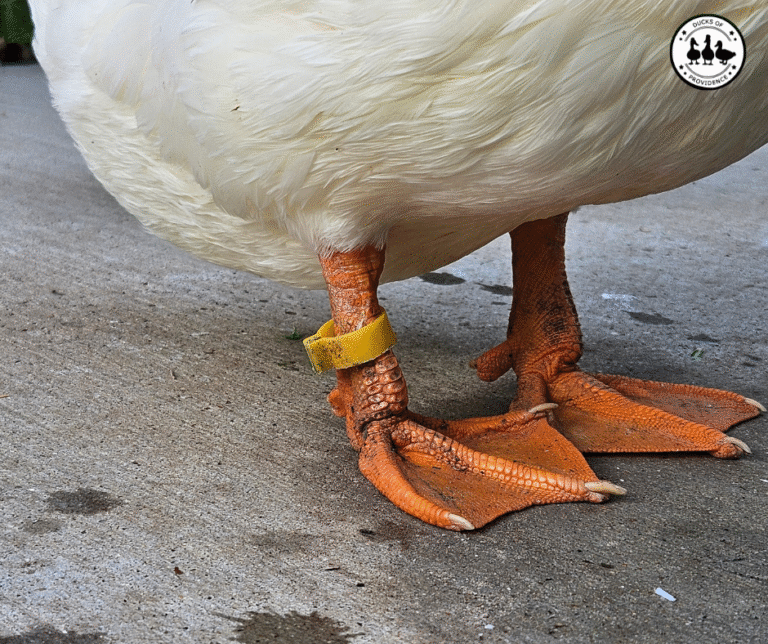

I really enjoyed reading your engaging and comprehensive webpage. I’ve been raising farm birds since 1998, and Muscovies are my very favorite. Years ago, five adolescent Muscovy ducks appeared on my farm. There seem to be about 100 now. I brought in Rouen ducklings this spring, raising them with the many, many, many Muscovy ducklings. My plan is for the Rouens to interbreed with the Muscovies and produce sterile hybrids. Fingers crossed this works. 🙂
Wow, that’s a lot of ducks 😯 Good luck with your breeding plans.